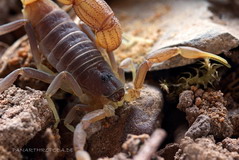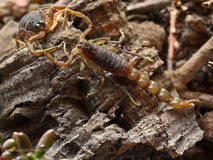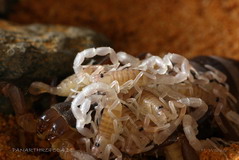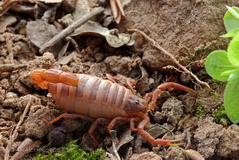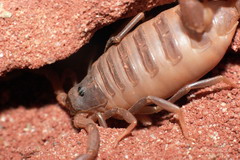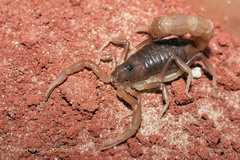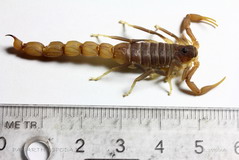- Akravidae
- Bothriuridae
- Buthidae
- Babycurus jacksoni
- Centruroides gracilis
- Centruroides meisei
- Centruroides nigrenscens
- Hottentotta hottentotta
- Lychas mucronatus
- Lychas scutilus
- Parabuthus pallidus
- Parabuthus raudus
- Parabuthus villosus "black"
- Caraboctonidae
- Chactidae
- Chaerilidae
- Euscorpiidae
- Hemiscorpiidae
- Iuridae
- Pseudochactidae
- Scorpionidae
- Superstitioniidae
- Troglotayosicidae
- Typhlochactidae
- Vaejovidae

Parabuthus pallidus (Pocock, 1895)
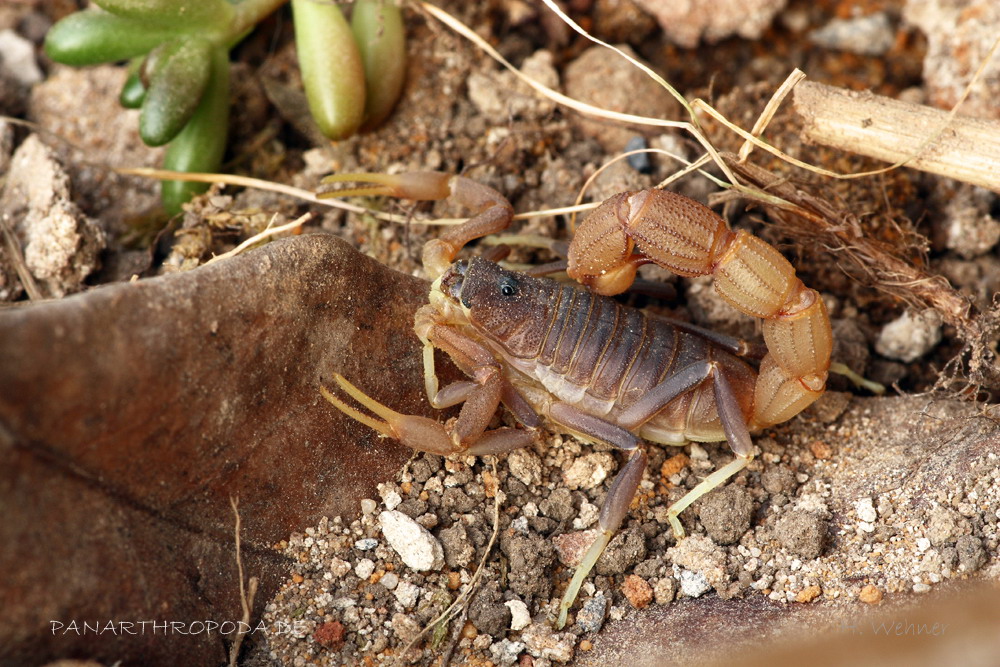
1.0 Parabuthus pallidus
Origin and occurrence
Parabuthus pallidus lives in Ethopia, Kenya, Somalia und Tanzania. He inhabits arid and semi-arid veld and savannahs.
In Kenya P. pallidus shares its distribution range with Parabuthus liosoma and even settles in the same habitats (Scorpion-Files).
Except for the rainy season (which differs in strengths and timing depending on regional provenance, climate-charts for the differnet countries can be found e.g. here), the habitats of P. pallidus have a pretty dry climate, however air humidity may rise at times, e.g. at foggy mornings.
Appearance and sexual dimorphism
Parabuthus pallidus is claimed to reach lenghts up to 10cm (~4inch) (PROBST 1973), I only have seen specimens around 4-5cm (1,6-2 inches). I don't know if this has its reason in different populations, different origins or if mostly smaller specimen bred in captivity.
Typical for Parabuthus spp., P. pallidus has a broad and heavily granulated metasoma. It shows relatively much hair, but not as much as e.g. Parabuthus villosus. Additionally, the hairs of P. pallidus are pretty thin and of pale colour, so that you may oversee them at a fast glance.
Most Parabuthus pallidus feature a brown base colour, while the metasoma is slightly brighter and may show a touch of orange.
The coloration of the legs fades to a bone-white colour.
Depending on locality, colouration may vary from yellow, orange, bright and dark brown to nearly black specimen (scorpionforum).
Like several other Parabuthus spp., the metasomal segments I and II of P. pallidus feature a granulation which resembles sand-paper on the inner side.
When threatened and/or provoked, they scratch over these areas with their aculeus, generating sharp, snapping noises (stridulation). This is an unmistakable sign that they are extremely stressed and should be left alone.
Female specimens are bigger and bulkier than males. Unlike several other Parabuthus spp., adult males of P. pallidus don't feature a bulky manus, but have as delicate pedipalps as females.
If one does not want to sex the animals on the basis of factors such as size and build (which would be possible only with several adult specimen to compare), one must fall back to other characteristics.
The often used method of counting the pectinal teeth promises rather little success: the only official source (known to me) describes the number of teeth with 27-40, whereby the 27 is provided with the additive „female“ and the 40 with „male“ (1973 PROBST). Where and whether the sexes overlap, is not evident from this.
If one isn't lucky and wants to sex a specimen with very few or very many pectinal teeth, one can't rely on this method either.
Nevertheless one can determine the sex 100% with the help of the comb organs, because like most Parabuthus spp., female Parabuthus pallidus have a so-called proximal median lamella, a rag-like, enlarged comb tooth directly at the beginning of the comb organs.
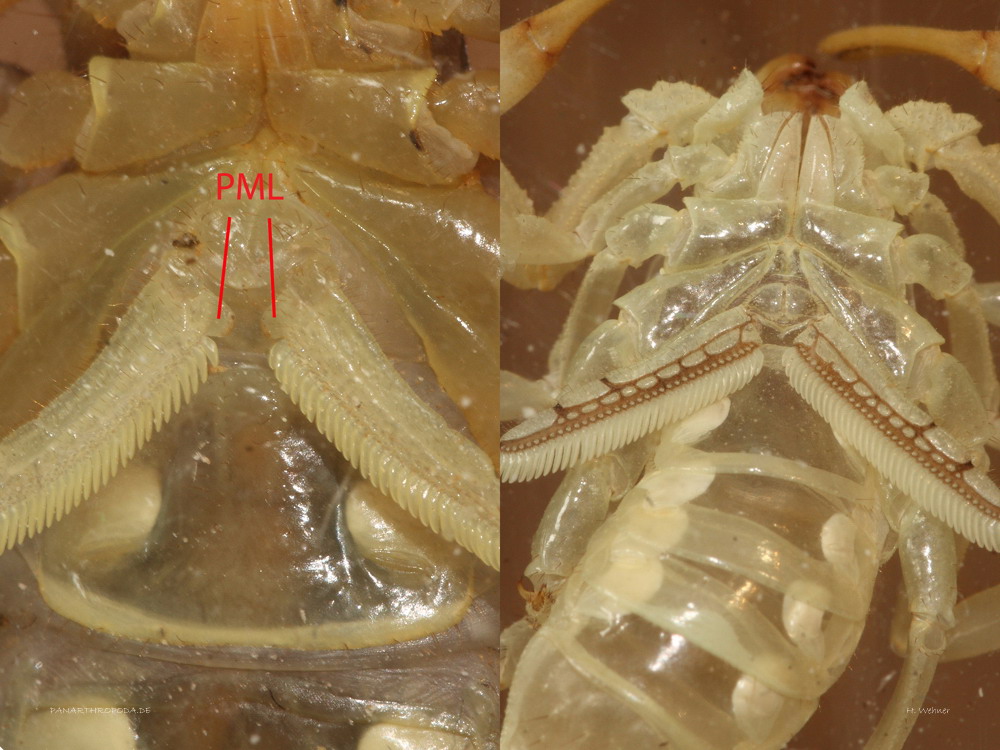
Comparison of comb organs from 1.0 und 0.1 with marked proximal median lamella. Left: 0.1 in ventral view. Right: 1.0 exuviae.
This method is not only more reliable than a counting of the pectinal teeth, but also more comfortably and faster.
Keeping conditions
Parabuthus pallidus settles quite dry and warm areas, where it can come to increased air humidity by rainy seasons and morning-fog from time to time.
Since, like mentioned above, P. pallidus inhabits savannahs an veld, so there are rocky areas as well as areas with different vegetation.
All this should be concerned when setting up a terrarium.
Since P. pallidus is a burrower, the substrate should consist of a sand/clay-mixture, so that the specimen can dig their tunnels. The substrate should be filled in as high as possible according ti the size of the enclosure.
Additionally one should place several stones, pieces of bark or little shrubs as possible hide-outs.
For means of decoration plants like succulents and Tillandsias can be placed in the enclosure as well, dry grass and some twigs help creating a more natural look.
P. pallidus can be held in small groups (e.g. 2.1), but one should only take one female per group, since they tend to be incompatible. If one goes for a group, there are several aspects to consider:
-there need to be more hiding possibilities than scorpions in the enclosure,
Alle Tiere sollten möglichst zeitgleich in das Terrarium gesetzt werden, um Revierstreitigkeiten zu vermeiden.
-the scorpions have to be fed more often,
-all scorpions should be put in the enclosure at once, so that there won't be territorial fights.
The scorpions should be watched closely, especially for the first few days, so that fights can be intervened. If they start fighting each other and won't stop, they have to be seperated and put in different enclosures.
But even after a long time of peaceful co-existence, fights can break out all of a sudden.
There is no guarantee and no secret recipe for succesfully keeping groups of scorpions together.
P. pallidus is fed with everything they can overwhelm: Grasshoppers, Crickets, Roaches, Beetles... there are plenty of animals to be preyed upon, so there should be a nice variating menu for the scorpions.
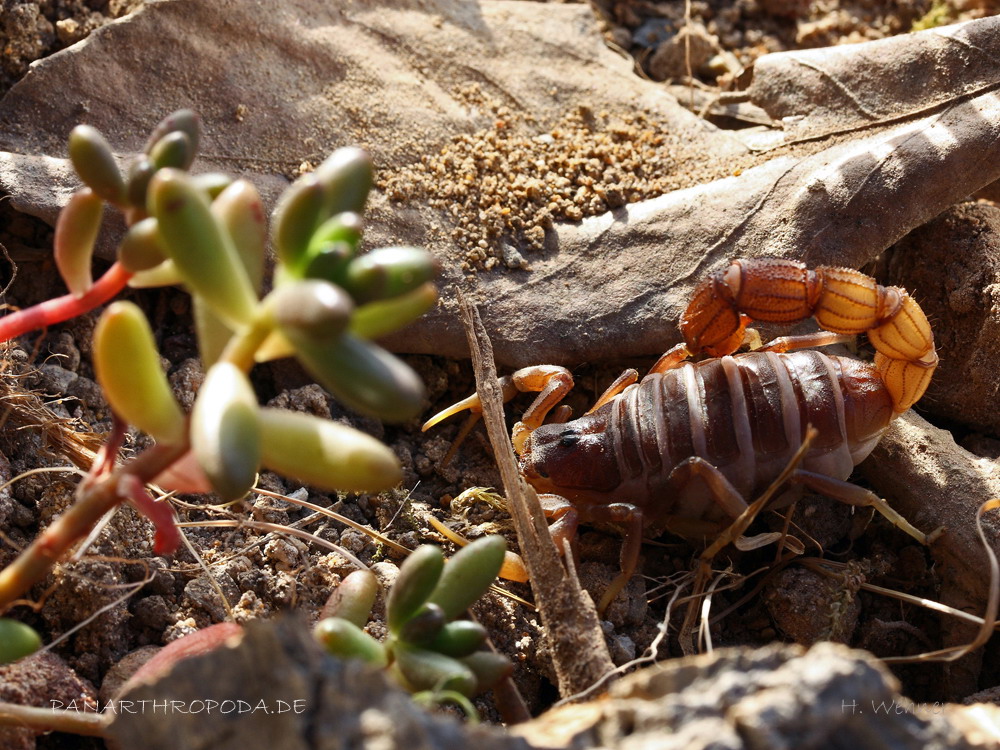
0.1 Parabuthus pallidus
On to the size of the enclosure: since P. pallidus aren't very big scorpions, they don't need that much space.
For a single specimen an enclosure with about 20/20/20 (~8/8/8inch) should be sufficient. I keep an adult pair on 20/30/20cm (~8/12/8inch) and there hasn't been any trouble ever.
Most of the time, the scorpions live in the same tunnel, sometimes they wander aound on their on for a while.
Temperature in the enclosure should lie around 27-32°C (~80-90°F). Light and heat can be provided by common halogen-spotlamps. Directly under the spot, temperatures may rise to about 40°C (~104°F). Gravid females somtetimes like to „sunbathe“ in these „hot-spots“.
About the water-supply: every 2-3 weeks a little bit of water should be presented to the scorpions. Just fill up the lid of a bottle or something like that and put it in the enclosure. While doing that, a part of the enclosure should be sprayed with some water, too (damp, not wet!).
While a hibernation period isn't necessary due to the climate in the natural habitats, keepers of P. pallidus may want to simulate the rainy season by giving more water than usual (don't overdo it though).
Mating and raising the young
Mating P. pallidus is pretty simple. If you keep a pair or a group of several adult specimen, sooner or later there will be offspring.
Males become adult in Instar 6, Females in Instar 7.
If you keep the scorpions separated and just put them together for mating, here are some points to consider:
-feed both specimen before putting them in the mating enclosure
-put them in a neutral enclosure to avoid territorial fights
-put the female in the enclosure a few minuts before the male, so it can set a trace for the male to follow
-the mating enclosure should be held clearly arranged, some rocks and pices of wood should be put in ther where the male can put it's spermatophore. I made the experience that pieces of cork are preferred over stones and other wood.
When mating starts, the male will grab the female by its chelae and drag her around the enclosure, trying to find a place to place the spermatophore. This „dance“ can last for only a few minutes up to an hour or even longer.
Finally the male will place it's spermatophore and drag the female over it, so that the sperm-package can be inserted in the female's operculum genitalis.
After that is done, the scorpions will split up more or less peacefully.
They then can be separated and be put back in their enclosures again.
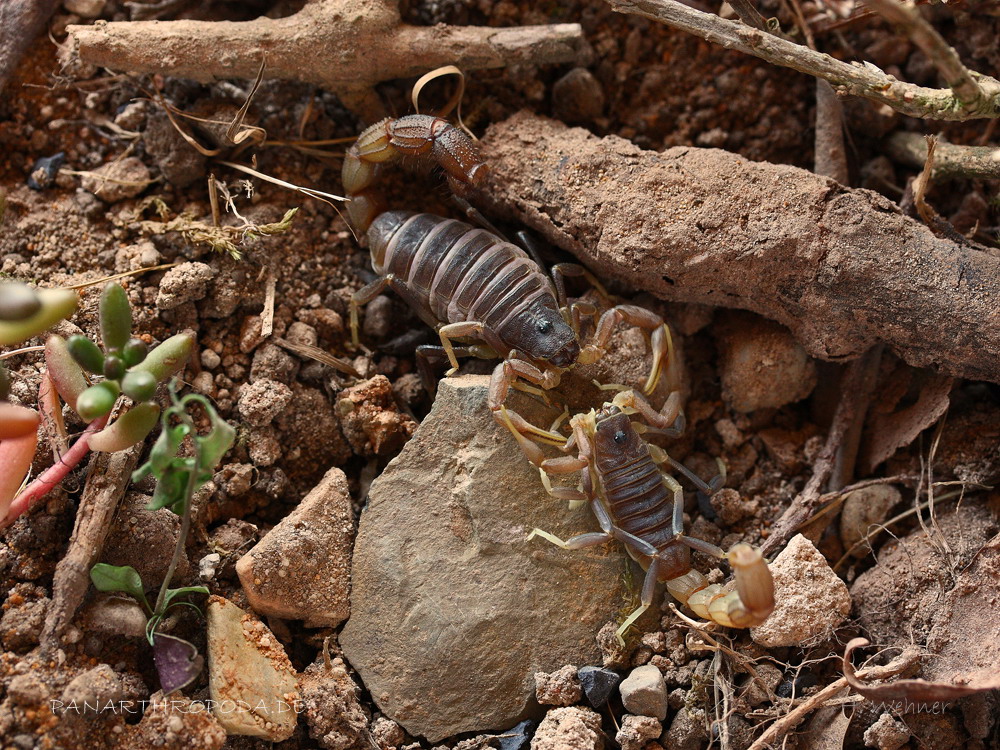
Mating Parabuthus pallidus
After about 6-8 months, the female will give birth to around 20-30 scorplings. Some time before that, the young will be visible as white spots through the pleural membrane. At that time, the female should be transferred into a clearly arranged enclosure (water-supply and one hiding spot is enough). This way one ensures to have good access to the young after the leave their mothers back.
Keep a close look at the temperature, if it's not warm enough, the female will delay the birth of the young.
When born, the scorplings climb onto the mother's back and stay there for the first few das of their lives. At that time, pre-killed food can be served to the female.
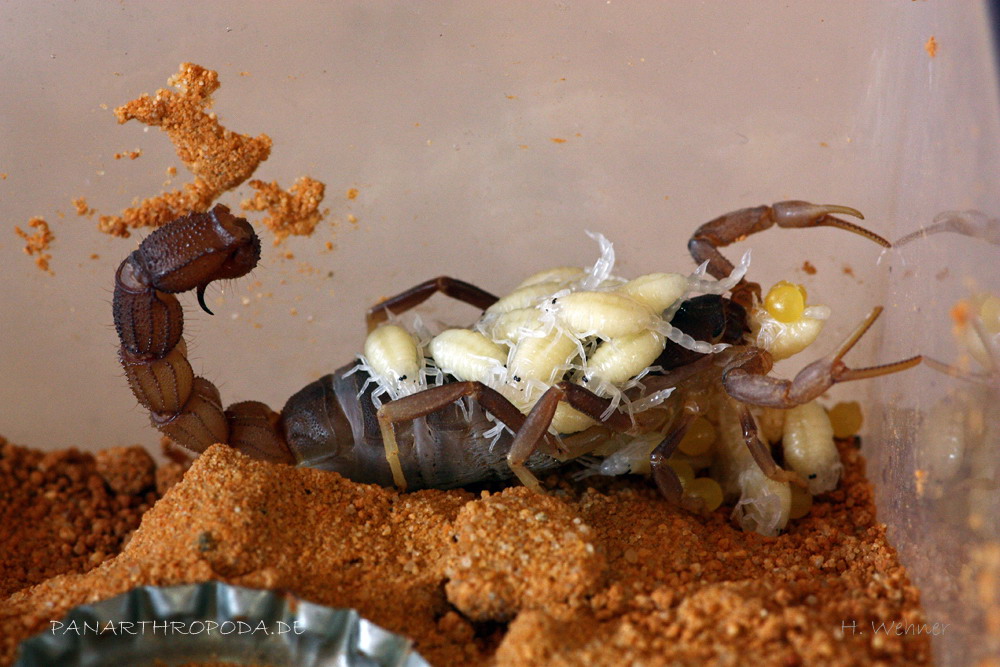
0.1 with instar 1 scorplings on its back.
After about 1-2 weeks the scorplings will molt into instar 2 on the female's back. Some days after that, they will leave the back and are ready to be seperated into their upbringing enclosures.
For P. pallidus I recommend raising them all in seperate enclosures, since they tend to prey upon each other even if other food is around sometimes.
The young should be raised at about the same temperatures as adult specimen, maybe 1-2°C cooler. In the early instars (2i-i3) humidity is more important. The enclosures should be sprayed with water 1-2 times a week. When instar 4 is reached, this can be reduced to spraying only every one or two weeks.
The scorplings should be fed every 3-4 days with animals of the appropriate size (they can and will overwhelm almost anything up to their own bodysize).
When keeping them under these conditions, Parabuthus pallidus can reach the adult staium in under a year. Males will need about 8-9 month, females about 9-11 month.
Behavior and venomousness
As for every other animal, the behaviour of P. pallidus can't be described universally, since there may be calm specimens as well as more offensive ones.
I got to know P. pallidus as a quite peaceful terrarium-inhabitant. My adult pair lives together without any problems since a long period of time, sometimes close to each other, sometimes with a little distance.
I never saw a fight between these two. Both scorpions can sometimes be seen outside of their burrows, waiting for prey or wandering around the enclosure. When I touch the terrarium, they will both disappear in their burrows and usually won't come out for a few hours or even for the rest of the evening/night.
That makes it pretty easy to work in the enclosure (e.g. change defect spotlamps, remove leftovers from feeding...). Nevertheless one should always have one eye focused on the entrance of the burrows, so that the scorpions won't surprise you.
There is no explicit data on the venomousness of Parabuthus pallidus, but since they belong to the Buthidae, their venom should be considered potentially dangerous. The ability of some Parabuthus spp. to spray their venom wasn't recorded for P. pallidus by now (scorpion files).
Über die Giftpotenz von Parabuthus pallidus sind keine Quellenangaben vorhanden, da aber Buthiden im allgemeinen eher starkes Gift besitzen und Parabuthus spp. insgesamt für ihre teilweise sehr starke Giftwirkung bekannt sind, sollte man auch bei P. pallidus davon ausgehen, dass er ein recht potentes Gift besitzt. Die bei mehreren Parabuthus spp. beobachtete Fähigkeit, Gift über größerere Distanzen zu versprühen, konnte bei P. pallidus bisher nicht nachgewiesen werden (Scorpion-Files).
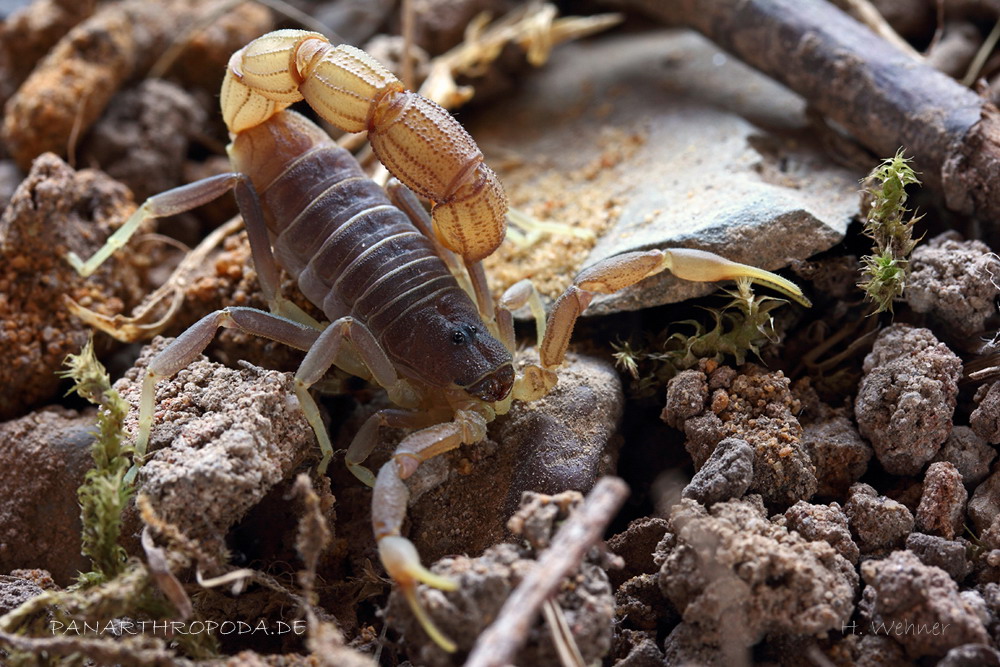
1.0 Parabuthus pallidus
References
-FET et al.(1758-1998): Catalog of the Scorpions of the World: 208
-Scorpion-Files: http://www.ntnu.no/ub/scorpion-files/p_pallidus.php
-www.iten-online.ch/klima/afrika/afrika.htm
-scorpionforum: http://scorpionforum.darkbb.com/scorpion-id-f17/parabuthus-mossambicensis-t2262-15.htm Post von Peter/Skywalker bezüglich der verschiedenen Farbformen.
-eigene Erfahrungen
H. Wehner, authored 2010


